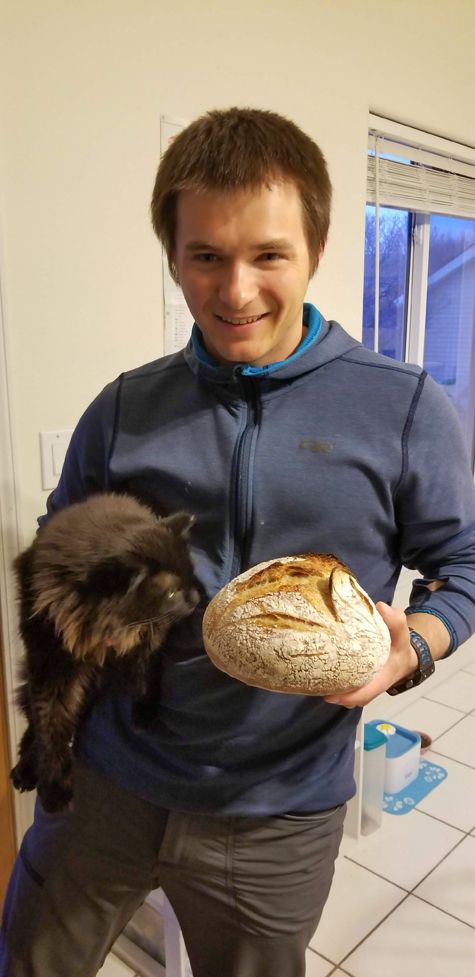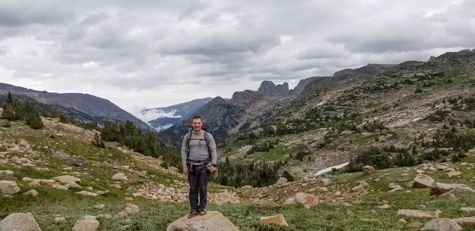Early Career Scientist Spotlight
Dr. Mykhaylo (Mike) Shumko (he/him/his)
Magnetospheric Physicist
Ionosphere, Thermosphere, Mesosphere Physics Laboratory (675)
What is your research focus?
My space physics research is focused on particle precipitation into Earth’s atmosphere from the inner magnetosphere (the region of outer space right above our atmosphere). In graduate school, my research focused on a type of energetic electron precipitation called microbursts. Microbursts can be thought of as electron “rain drops” that originate somewhere in the outer Van Allen radiation belt, gyrate towards Earth along its magnetic field lines, and then impact Earth’s atmosphere. One reason that microbursts fascinate me is their sub-second duration, during which the electron flux increases by as much as 10-100 times. I study microbursts by primarily using electron time series measurements made by various satellites with an emphasis on the FIREBIRD-II and AC-6 CubeSats.
As a postdoc at Goddard, my research has largely remained focused on microbursts, but I’ve pivoted my research methods and have begun analyzing auroral all-sky images taken by the THEMIS and REGO cameras in Canada. The broad science question that I aim to answer is: under what conditions can we use auroral images to infer the outer radiation belt dynamics? The auroral light that I study is emitted by low energy electrons (< 10s keV), while the microbursts that I study are much higher energies (100s keV – MeV). The 10x-100x difference between these energies, and the different observational techniques used to study them, have historically led to the two science communities working largely independently. I am now combining the remote sensing auroral images with in-situ particle observations---in effect, combining the geographically large coverage of auroral imagers with in-situ electron observations, to understand under what conditions the aurora can be used to infer dynamics of the much higher electron precipitation.
If you want to learn more about my work, feel free to visit my website.
What motivated you to pursue a career in space physics?
My parents’ careers as astronomers strongly influenced my decision to pursue astrophysics in undergrad. However, I quickly realized that I like astronomy for its beauty and mysteries, more than the day-to-day research work. Concurrently, I visited the Space Sciences and Engineering Laboratory (SSEL) in Montana State University. There, Keith Mashburn (not the Mayor of Simi Valley) gave me a tour of the CubeSat hardware and the ground station radios necessary to talk to the CubeSats once they are in orbit. Previously, I thought working on spacecraft was reserved for large organizations, but here I was in front of student-built space hardware! The opportunity to understand and develop successful satellite hardware and data pipelines was enticing. While this was not quite astronomy, working in space physics tickled my fascination with the part of outer space that has a direct impact on humanity.

Credit: Columbia Scientific Balloon Facility
What is an interesting problem or hurdle you’ve overcome in your work?
A hurdle that is relevant to many scientists, especially during the pandemic, is imposter syndrome. I’ve only recently identified it as a problem, and it has been a bumpy road to free myself of it. A few months ago, I had an epiphany when chatting with Dr. Ashley Greeley (672 lab) about this topic; I realized that, in college, many of my professors and some of my peers would frequently express surprise or frustration when I “didn’t get” what they were trying to explain (imagine me giving them a blank stare). This made me feel incompetent and that I was unwelcome in their intellectual space. This continued for almost a decade of college, leaving imposter syndrome deeply entrenched in my psyche.
Recently, I’ve shifted the way I self-reflect during these moments. I have learned to appreciate the saying that “everyone has a preferred learning style”. I often struggle to grasp concepts presented in lectures or traditional homework sets; however, I have discovered that I learn very well by diving deep into research. Now, when I do not understand something, I avoid intellectually shaming myself. Rather, I ask myself two broad questions: was the topic presented in a way that makes the most sense to me, and am I missing some knowledge fundamental to this topic? This shift in mindset, together with very supportive mentors, has helped me identify and reduce the effects of imposter syndrome.
What do you enjoy the most about your job?
As a postdoc, I enjoy the independence to pursue my research ideas and the feeling I get when I discover something interesting. I am thankful for the unrelenting support from my mentors: Dr. Alexa Halford and Dr. Lauren Blum. They support me in my pursuit to work on unusual projects, such as developing a comprehensive aurora analysis software. Initially, that project didn’t have a direct scientific contribution but, later, it helped me rapidly and thoroughly analyze auroral image data.
What science question intrigues you the most?
As described in my research focus, I’d say that the most intriguing science question is the connection between the aurora and radiation belt dynamics. I don’t think many people have thoroughly compared the two types of data sets, and I believe that we have a lot to learn from combining these measurements.

Credit: Alexandria Wilkins
What do you like to do in your free time?
In my free time, I occupy myself with reading non-fiction; although, from time to time, I read a fiction book to give my brain a break from intense thinking. Also, along with many others, I’ve started baking sourdough bread during the pandemic. Nothing beats the enticing aroma of a fresh loaf. Lastly, I enjoy being surrounded by nature when I’m on runs, hikes, and bike rides.
What is a fun fact about you?
I’ve made omelets every other day for about a decade. If I switch careers, I want to open an omelet restaurant called “Omeleta” that, as you probably already guessed, only serves omelets.

Credit: Patrick Hutchins
Biography
Home Town:
Nauchny, Crimea and Big Bear, California
Undergraduate Degree:
B.S. in Astrophysics, University of California Santa Cruz, Santa Cruz, California
Post-graduate Degrees:
Ph.D in Physics, Montana State University, Bozeman, Montana

